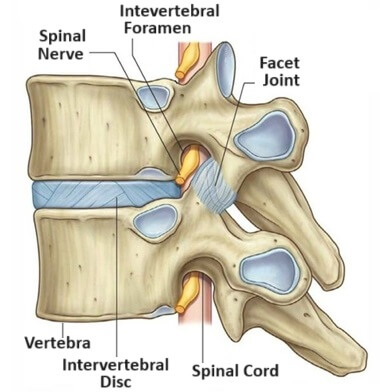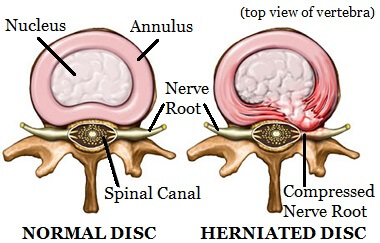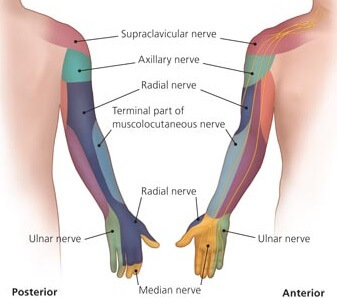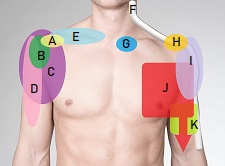- Home
- Diagnosis Guide
- Arm Nerve Pain
Arm Nerve Pain
Written By: Chloe Wilson BSc (Hons) Physiotherapy
Reviewed By: SPE Medical Review Board

Arm nerve pain is a common problem caused by pressure or irritation of one of the arm nerves, anywhere along its path from the neck to the hand.
Nerve damage typically causes a stabbing, shooting or burning pain in the arm and may be accompanied by tingling or decreased sensation in the arm or hand.
Whilst it is rare for there to be a pinched nerve in the shoulder itself, arm nerve pain usually develops due to a problem in the neck, wrist or elbow.
Here we are going to look at the most common causes of arm nerve pain. As most cases of arm and shoulder nerve pain actually come from a problem in the neck, we will start there and then go on to look at what happens if there is a pinched nerve in the arm. We will also look at how to tell whether the problem is coming from your neck or further down the arm, and the best ways to treat arm nerve pain.
How Do Nerves Work?

The neck is made up of seven bones, known as vertebra, that sit on top of each other - imagine a stack of cotton reels.
In between the bones are squashy oblong structures known as intervertebral discs - imagine jam donuts. Running down through the middle of the spine, from the bottom of the brain, is a long cable known as the spinal cord – imagine a tree trunk.
At each spinal level (each cotton reel), a pair of nerves (known as nerve roots) divides off the spinal cord. They branch out through gaps at the side of the vertebrae known as the intervertebral foramen and, in the case of the neck, the nerves extend down various parts of the arm to the hand – imagine branches coming off the tree trunk.
These nerves have receptor cells which are looking for information to send to the brain. They also link with muscles telling them when and how to move. Signals travel up and down the nerves (known as the peripheral nervous system), to and from the brain and spinal cord (the central nervous system). Let me give you an example: when you place your hand on a table, signals travel from the peripheral to the central nervous system to tell you that you are touching something. The peripheral and central nervous system work together to decipher what the surface feels like e.g. hot, cold, rough, smooth as well as information such as how much pressure you are putting through your hand.
The central nervous system sends out instructions (e.g. to move) and interprets incoming signals (e.g. touch – sharp, hot etc). At the same time the peripheral nervous system passes the messages along, to and from the brain and carries out the appropriate actions (e.g. tells muscles to move).
Anything that affects how the messages are transferred up and down through the central and peripheral nervous system can result in pain, weakness and altered sensation in the neck, shoulder, arm and even down into the hands. In fact, nerve pain is the most common cause of pain from shoulder to hand.
How Do Nerves Get Damaged?
Neural damage that results in arm nerve pain can be caused by:
- Mechanical Compression: where there is impingement or compression of the spinal cord or nerve
- Chemical Irritation: Inflammatory chemicals such as pro-inflammatory cytokines irritate the nerve making it more sensitive to stimuli.
Nerve damage may occur right at the origin of the nerve in the neck, or anywhere down it's path through the forearm and into the hand.
Let’s look at the most common causes of nerve damage that cause shoulder and arm pain.
1. Disc Disease

Shoulder and arm nerve pain is often due to a problem in one of the spinal discs in the neck.
Each disc has a thick outer layer of cartilage, the annulus, and inner gel-like material, the nucleus.
As we move, different parts of the disc are compressed. For example, when we bend forwards, pressure goes through the front of the disc and when we bend backwards the back portion of the disc is compressed.
The discs are designed to cope with this and are there to allow the spine to move smoothly, but if there is sufficient force, or repetitive overloading on the discs, then damage can occur which affects the nearby spinal nerves.
There may be a:
- Disc Bulge: This is when the central gel-like portion of the disc (the nucleus) protrudes out placing pressure on the nerve root through mechanical compression.
- Disc Degeneration: As we age, our discs dehydrate, becoming less plump, less flexible and weaker – think now of a stale donut. It provides less space between the vertebrae, less cushioning, it doesn’t adapt as well to movement and it is more likely to get damaged, any of which can lead to pressure on the nerve root through mechanical compression.
- Disc Herniation: This is where a tear develops in the discs outer layer allowing the nucleus to leak out, collecting around and irritating the nerve root – imagine squashing a donut until the jam escapes out. This is the most common example of nerve damage from chemical irritation.
Disc herniation is often unhelpfully referred to as a “slipped disc”. This term is misleading - the disc itself does not pop in and out, it is firmly held in place, it is only the nucleus that leaks out.
Any of these types of disc disease can result in nerve damage which can causes arm nerve pain. You can find out loads more about the specific symptoms associated with cervical disc disease in the burning shoulder pain article.
2. Spinal Stenosis
Spinal stenosis is when there is narrowing of one or more of the spinal foramina, the bony openings in the spine where the spinal cord and nerves sit. Spinal stenosis can occur at the:
- Spinal Canal: the hole in the vertebrae that the spinal cord runs down through
- Intervertebral Foramina: the gaps at the side of the spine where the nerves exit the spinal cord
If there is sufficient narrowing at either of these places, it can place pressure and compression through the spinal cord or spinal nerves leading to arm nerve pain.
Spinal stenosis may be caused by:
- Osteoarthritis: OA is the most common cause of spinal stenosis and is typically associated with aging. Gradual wear and tear of the cartilage that lines the joints in the spine reduces the joint space. This loss of space and cushioning causes the bones to start rubbing against each other resulting in inflammation and abnormal bone growth, known as bone spurs or osteophytes. These bone spurs cause further narrowing of the foramina and compress the nerve.
- Ankylosing Spondylitis: this is a chronic inflammatory type of arthritis that can also result in bone spur formation and thus nerve irritation.
- Ligament Ossification: Here calcium deposits form in the posterior longitudinal ligament, the ligament that runs through the spinal canal. As the ligament ossifies, it thickens and forms bony tissue that can encroach on the spinal cord or nearby nerves.
- Pagets Disease: A chronic condition affecting how bones rejuvenate. Pagets disease causes the body to make new bone faster than normal.
- Spinal Tumour: Abnormal tissue growth in and around the spine may place pressure on the spinal cord or nearby nerves.
- Spinal Injuries: Fractures of the spine may cause bone fragments to place pressure on the spinal nerves.
Spinal stenosis can occur anywhere in the spine but when it affects the neck it is known as cervical stenosis. Many people with cervical stenosis have no symptoms but as the disease progresses it can lead to arm nerve pain. You can find out more about the specific symptoms of spinal stenosis in the burning arm pain section.
Most cases of arm nerve pain from spinal stenosis can be treated non-operatively with a combination of physical therapy, exercises, medication and activity modification. However, if there is severe narrowing, then surgery may be required to remove some of the bone to relieve the pressure on the spinal cord or nerves.
3. Peripheral Nerve Damage

Whilst a majority of cases of arm nerve pain originate from a problem in the neck, nerve damage can also occur anywhere along the path of the nerve as it travels through the shoulder and arm to the hand.
A pinched nerve in the shoulder or arm happens when something either internal or external to the body squashes the nerve. The compression irritates the nerve and can cause inflammation which leads to arm nerve pain. The medical term for a pinched nerve is nerve entrapment.
Any of the nerves that come from the neck and travel down the arm may be affected:
- Supraclavicular Nerve: Supplies the top part of the shoulder, front and back aspect, down from the neck
- Axillary Nerve: Supplies the top part of the upper arm and the arm pit
- Median Nerve: runs down the centre of your arm supplying sensation to the palmar aspect of the middle three fingers. The most common peripheral median nerve injury is carpal tunnel syndrome.
- Ulna Nerve: runs down the little finger side of the arm supplying sensation to both sides of the ring and little finger. When you hit your “funny bone” you are actually compressing the ulna nerve. Compression of the ulna nerve at the elbow is known as cubital tunnel syndrome and causes tingling and numbness in the ring and little fingers.
- Radial Nerve: runs down the thumb side of the arm supplying sensation to your whole thumb and the back of your hand to your index and middle finger. The most common peripheral radial nerve injury is radial tunnel syndrome.
A pinched nerve in the arm most commonly occurs at the elbow or the wrist where the nerves travel through narrow spaces and passageways formed by bones and other tissues, often resulting in pain in the forearm and hand.
How Does Nerve Damage Cause Pain?
Damage to the nerves affects how the signals travel. There may be:
- Irritation: if something irritates the nerve e.g. chemicals from inflammation or a disc bulge, it will send extra signals to the brain which may result in feelings such as pain, tingling or burning
- Blocked Signals: if there is sufficient pressure on the nerve, the signals can’t get through properly so the brain has less or no input signals to interpret. For example, numbness – you may rub an area of the skin but the message doesn’t get through to the brain so you aren’t aware of the pressure. This can be particularly serious if you touch something hot or sharp as the reflex to withdraw from it isn’t there.
- Extra Receptors: The body responds to an injury by increasing the number of receptors around the area – the parts of the nerve that are seeking information. Imagine the receptor is like a buzzer – when something presses on the buzzer, it makes a noise. Now imagine a normal elbow had one receptor (in reality it has way more than one!), but you recently injured the elbow so the body produced extra receptors because the brain wants to keep a close eye on the area to protect it from further damage.
This time, when something happens to trigger the buzzer, instead of one buzzer going off, 5 buzzers go off – a much louder signal for the brain. In the short term after an injury this is helpful as it helps protect the area from further damage. Over time, the number of receptors should return to 1, but sometimes extra receptors remain, even though the initial damage has fully healed. The brain continues to receive extra messages which can lead to ongoing feelings of pain and altered sensation, even when the area has healed. - Hypersensitivity: if a nerve has been sending more signals to the brain than usual e.g. after an injury, it can become hypersensitive. Over time the nerves threshold can drop, which means it takes a smaller stimulus to fire messages up to the brain – think again of the buzzer – rather than needing a good press to make it sound, the lightest touch now activates it.
It can get to a point where a normal stimulus such as light touch on the area sends a warning message to the brain which it interprets as danger. Hypersensitivity can cause us to feel an over exaggerated level of pain to a minor painful stimulus, known as allodynia, or even to feel pain from a normally non-painful stimulus, known as hyperalgesia. - Random Firing: If nerves have been irritated for a while, they can get so used to sending messages to the central nervous system, that they may randomly send messages even when nothing has happened. This is why some people find they get arm nerve pain, even when they are sitting still and there has been no trigger for the message.
Symptoms Of Arm Nerve Pain
Pain in the shoulder or arm that is due to nerve irritation or spinal damage presents differently to problems in the muscles, bones, tendons or ligaments of the shoulder. If the pain in your shoulder or arm is due to nerve damage you may experience:
- Pain: a stabbing, shooting pain or burning sensation that may extend down your arm. At times you might experience a sensation like an electric shock.
- Altered Sensation: tingling like pins and needles or decreased sensation to pressure – people sometimes say it feels like they are wearing a pair of gloves.
- Weakness: in your shoulder, arm or hands
The first symptom of mild nerve compression or irritation is usually pain. Arm nerve pain tends to get progressively worse becoming more intense and extending further down the arm as the compression increases. Tingling or pins and needles may be felt, not necessarily in the same location as the pain e.g. there may be a shooting pain in your upper arm but tingling in your fingers.
With more major nerve compression, you may start to lose feeling in your hands. Some people actually find they have less pain when this happens, but any loss of sensation should be investigated as soon as possible by your doctor.
Neck or Arm?
So how do you tell if your arm nerve pain is from compression in the neck or down the arm?
It is very uncommon for there to be a trapped nerve in the shoulder itself. Shoulder nerve pain is almost always caused by compression or irritation of the nerve root at the spine. So if you are experiencing arm nerve pain around the neck, shoulder or upper arm, it is likely that the problem is actually coming from the neck.
If your symptoms are below the elbow or in the hand, then the problem could be in the neck, even if there are no symptoms in the neck or upper arm. This is quite common. When this is the case, symptoms will be affected more by neck movements and posture than arm and hand movements.
But what if the point of compression is somewhere in the arm rather than the neck? Symptoms of a pinched nerve will only be felt below the point of compression not above. This means if the compression point is at the wrist e.g carpal tunnel syndrome, there will be no pain, tingling or altered sensation in the upper arm. Nerve pain only travels down the nerve, not up it. So if you have symptoms around your neck or upper arm, it is unlikely to be from nerve compression below your elbow.
Check out our handy diagnosis chart comparing neck and shoulder problems.
Treating Arm Nerve Pain
If you are suffering from a pinched nerve in your shoulder, arm or neck, there are various things you can do to help treat arm nerve pain:
- Medication: talk to your doctor about what medication would be most suitable. If your symptoms of arm nerve pain are fairly mild, then over-the-counter medication may be sufficient but moderate to severe nerve pain often requires prescription strength medication.
- Physical Therapy: A physical therapist will be able to work on a rehab program with you to strengthen your neck and shoulder muscles to help reduce the pressure through the nerves. They can also help to correct any spinal mal-alignment that may be placing pressure on the nerves.
- Posture Correction: Having poor posture makes subtle changes to spinal position and can increase the pressure through parts of the discs and the nearby nerves. Working to improve your posture can reduce the pressure on the nerves and help relieve arm nerve pain. Thinking about your desk set up and how you sit can make a big difference as can exercises such as neck retractions and upper back stretches.
- Splint: If the nerve is being compressed in the wrist or elbow, then wearing a splint can help to reduce the pressure on the nerve. The most commonly used are a wrist splint for carpal tunnel syndrome where there is excess pressure on the median nerve at the wrist or an elbow splint when there is pressure on the ulna nerve at the elbow, known as cubital tunnel syndrome
Most cases of arm nerve pain will settle down with these treatments. However, if the mechanical compression or chemical irritation is sever enough, then you may need surgery to remove excess bone, tight ligaments or to repair a damage disc.
Summary
- The most common cause of arm nerve pain is mechanical compression in the neck.
- Typical symptoms include a stabbing, shooting pain, tingling and numbness.
- There may be a burning sensation in the shoulder, but that could be due to other problems such as brachial neuritis or shoulder bursitis
- Tingling or numbness is the hand is often due to compression in the forearm or wrist, resulting in carpal tunnel syndrome or cubital tunnel syndrome
- Whilst it is unusual to have a pinched nerve in the shoulder, nerve compression in the neck is fairly common.
- Most cases of arm nerve pain, symptoms will settle down with a combination of medication, physical therapy and exercises.
If this isn’t sounding quite like your pain, visit the shoulder pain diagnosis section for help working out what is wrong. You may also be interested in the following articles:
- Sharp Pain In Shoulder
- Shoulder Pain At Night
- Shoulder Lumps & Bumps
- Shoulder Stability Exercises
- Front Shoulder Pain
- Elbow Pain Diagnosis
- Forearm Pain Diagnosis
Related Articles
Page Last Updated: February 4th, 2025
Next Review Due: February 4th, 2027


